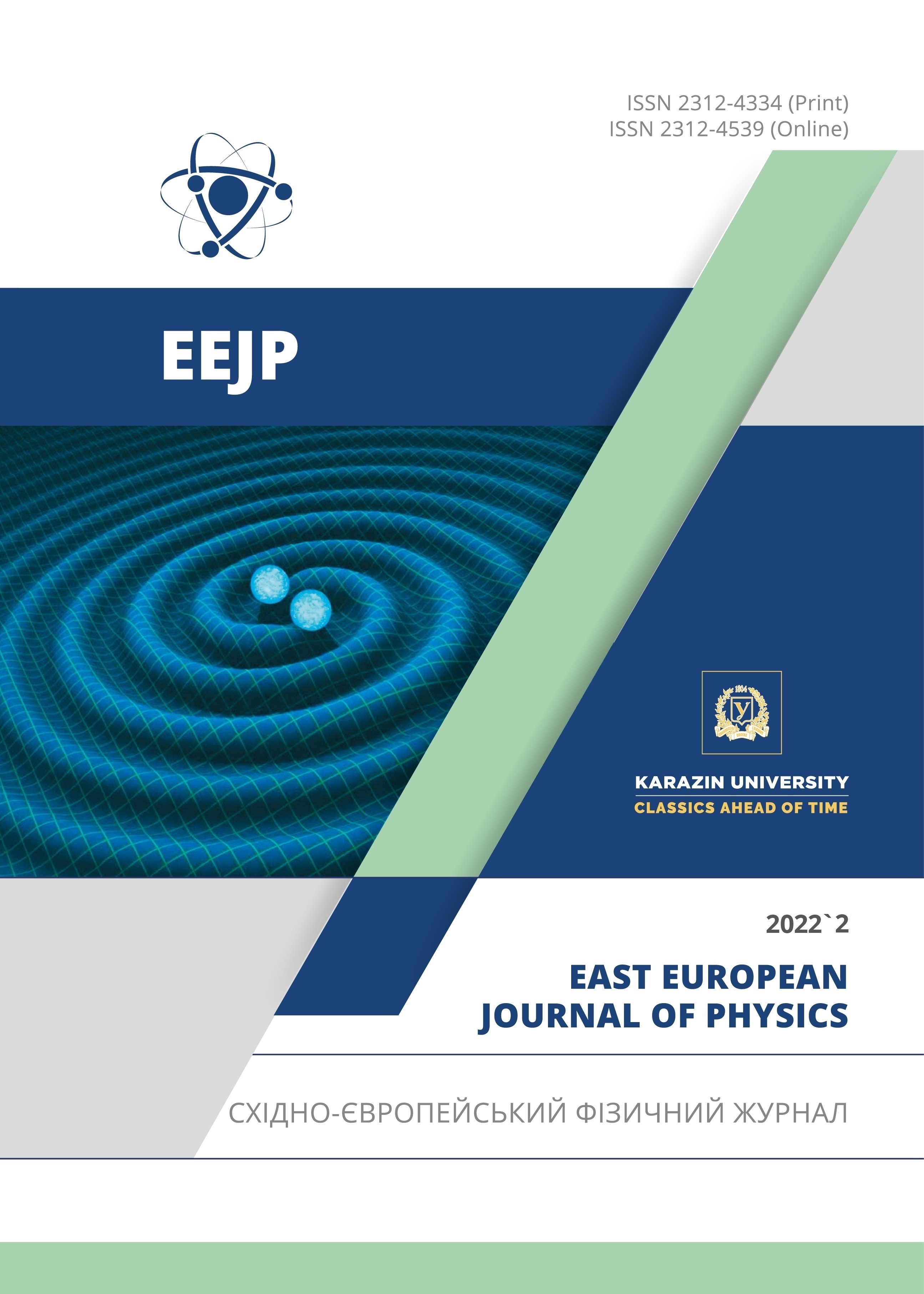Interaction of Novel Monomethine Cyanine Dyes with Proteins in Native and Amyloid States
Abstract
Molecular interactions between novel monomethine cyanine dyes and non-fibrilar and fibrilar proteins were assessed using fluorescence spectroscopy and molecular docking techniques. To this end, the fluorescence spectral properties of dyes have been explored in the buffer solution and in the presence of insulin and lysozyme in the native and amyloid states. It was observed that association of monomethines with the native and fibrillar proteins was accompanied with a significant enhancement of the fluorophore fluorescence, being more pronounced in the presence of aggregated insulin and lysozyme. The quantitative information about the dye-protein binding was obtained through approximating the experimental dependencies of the fluorescence intensity increase vs protein concentration by the Langmuir model. Analysis of the spectral properties and the binding characteristics of monomethines in the presence of the fibrillar insulin and lysozyme showed that the introduction of chloro- and fluorine-substitutients to the oxazole yellow derivatives, as well as the long aliphatic substitution on the nitrogen atom of the benzazole chromophore of YO-dyes had a negative impact on the dye amyloid specificity. Molecular docking studies showed that monomethines tend to form the most stable complexes with the B-chain residues Val 17, Leu17, Ala 14, Phe1, Gln 4 and Leu 6 and the A-chain residue Leu 13, Tyr 14, Glu 17 of non-fibrilar insulin and interact with the deep cleft of native lysozyme lined with both hydrophobic (Ile98, Ile 58, Thr108, Thr 62 and Thr 63 residues) and negatively (Asp101, Asp 107) charged residues. The wet surface groove Gln15_Glu17 and groove G2-L4/S8-W10 were found as the most energetically favorable binding sites for examined monomethine dyes in the presence of the insulin and lysozyme fibrils, respectively.
Downloads
References
T. Ishiguro, J. Saitoh, H. Yawata, M. Otsuka, T. Inoue, and Y. Sugiura, Nucleic Acids Res. 24, 4492-4497 (1996), https://doi.org/10.1093/nar/24.24.4992
A.S. Biebricher, I. Heller, R.F.H. Roijmans, and T.P. Hoekstra, et al, Nat. Commun. 6, 7304 (2015), https://doi.org/10.1038/ncomms8304
M. Wong, S. Kong, W. H. Dragovska, and M.B. Bally, Biochim. Biophys Acta, 1527, 61-72 (2001), https://doi.org/10.1016/S0304-4165(01)00149-50
A. Rozman, I. Crnolatac, T. Deligeorgiev, I. Piantanida, and J. Luminesc. 205, 87-96 (2019), https://doi.org/10.1016/j.jlumin.2018.08.074
A. Furstenberg, T. Deligeorgiev, N. Gadjev, A. Vasilev, and E. Vauthey, Chem. Eur. J. 13, 8600-8609 (2007), https://doi.org/10.1002/chem.200700665
H. Rye, S. Yue, D. Wemmer, M. Quesada, P. Haugland, R. Mathies, et al. Nucleic Acid Res. 20, 2803-2812 (1992), http://dx.doi.org/10.1093/nar/20.11.2803
C.U. Murade, V. Sabramaniam, C. Otto, and M.L. Bennink, Biophys. J. 97, 835-843 (2009), https://doi.org/10.1016/j.bpj.2009.05.024
S. Gurrieri, K. Wells, I. Johnson, and C. Bustamante, Anal. Biochem. 249, 44-53 (1997), http://dx.doi.org/10.1006/abio.1997.2102
Y. Sato, S. Yajima, A. Taguchi, K. Baba, M. Nakagomi, Y. Aiba, and S. Nishizawa, ChemComm. 55, 3183-3186 (2019),
O. Cavuslar, and H. Unal, RSC Advances. 5, 22380-22389 (2015),. http://dx.doi.org/10.1039/C5RA00236B
M. Eriksson, M. Härdelin, A. Larsson, J. Bergenholtz, B. Akerman, J. Phys. Chem. B 111, 1139-1148 (2007), http://dx.doi.org/10.1021/jp064322m
K. Vus, U. Tarabatra, Z. Balklava, D. Neruch, M. Stich, et al, J. Mol. Liq. 302, 112569 (2020), http://dx.doi.org/10.1016/j.molliq.2020.112569
M. Thompson, Bioconjugate Chem. 17, 507-513 (2006), http://dx.doi.org/10.1021/bc050307t
D.J. Lindberg, and E.K. Esbjorner, Biochem. Biophys. Res. Commun. 469, 313-318 (2016), http://dx.doi.org/10.1016/j.bbrc.2015.11.051
S. Stefansson, D.L Adams, and C.-M. Tang, Biotechniques, 52, 26307253 (2012), http://dx.doi.org/10.2144/000113873
K. Vus, V. Trusova, G. Gorbenko, E. Kirilova, G. Kirilov, I. Kalnina, and P. Kinnunen. Chem. Phys. Lett. 532, 110-115 (2012), http://dx.doi.org/10.1016/j.cplett.2012.02.061
S. Dallakyan, and A.J. Olson, Methods Mol. Biol. 1263, 243-250 (2015), https://doi.org/10.1007/978-1-4939-2269-7_19
P. Csizmadia, In: Proceedings of ECSOC-3, the third international electronic conference on synthetic organic chemistry, 367-369 (1999), https://doi.org/10.3390/ECSOC-3-01775
M.D. Hanwell, D.E. Curtis, D.C. Lonie, T. Vandermeersch, E. Zurek, and G.R. Hutchison, J. Cheminform. 4, 17 (2012), https://doi.org/10.1186/1758-2946-4-17.
V. Trusova, East Eur. J. Phys. 2, 51-58 (2015), https://doi.org/10.26565/2312-4334-2015-2-06
E.F. Pettersen, T.D. Goddard, C.C. Huang, G.S. Couch, D.M. Greenblatt, E.C. Meng, and T.E. Ferrin. J. Comput. Chem. 25, 1605-1612 (2004), https://doi.org/10.1002/jcc.20084
C.C. Kitts, T. Beke-Somfai, and B. Norden, Biochemistry, 50, 3451-3461 (2011), https://doi.org/10.1021/bi102016p
R. Mishra, D. Sjölander, and P. Hammarström, Mol. Biosyst. 7, 1232-1240 (2011), https://doi.org/10.1039/C0MB00236D
O. Zhytniakivska, A. Kurutos, U. Tarabara, K. Vus, V. Trusova, G. Gorbenko, N. Gadjev. And T. Deligeorgiev, J. Mol. Liq. 311, 113287 (2020), https://doi.org/10.1016/j.molliq.2020.113287
P.L. Donabedian, M. Evanoff, F.A. Monge, D.G. Whitten, and E.Y. Chi, ACS Omega, 2, 3192-3200 (2017), https://doi.org/10.1021/acsomega.7b00231
K. Volkova, V.B. Kovalska, M. Losytskyy, K.O. Fal, N.O. Derevyanko, et al. J. Fluoresc. 21, 775-784 (2011), https://doi.org/10.1007/s10895-010-0770-6
O. Ryzhova, K. Vus, V. Trusova, E. Kirilova, G. Kirilov, G. Gorbenko, and P. Kinnunen, Methods Appl. Fluoresc. 4, 034007 (2016), https:// /doi.org/10.1088/2050-6120/4/3/034007
V. Kovalska, S. Chernii, M. Losytskyy, I. Tretyakova, Y. Dovbii, A. Gorski, et al. New. J. Chem. 42, 13308-13318 (2018), https://doi.org/10.1039/C8NJ01020J
S. Salentin, S. Schreiber, V.Joachim Haupt, M.F. Adasme, and M. Schroeder, Nucleic Acids Res. 43, W443-W447 (2015), https://doi.org/10.1093/nar/gkv315
W. Peng, F. Dei, Y.-K. Peng, U.-T. Jiang, and L. Zang. J. Agr. Food Chem. 61, 12415-12428 (2013), https://doi.org/10.1021/jf4039327
M. Biancalana, and S. Koide, Biochim. Biophys. Acta, 1804, 1405–1412 (2010), https://doi.org/10.1016/j.bbapap.2010.04.001
Copyright (c) 2022 O. Zhytniakivska, U. Tarabara, A. Kurutos, K. Vus, V. Trusova, G. Gorbenko

This work is licensed under a Creative Commons Attribution 4.0 International License.
Authors who publish with this journal agree to the following terms:
- Authors retain copyright and grant the journal right of first publication with the work simultaneously licensed under a Creative Commons Attribution License that allows others to share the work with an acknowledgment of the work's authorship and initial publication in this journal.
- Authors are able to enter into separate, additional contractual arrangements for the non-exclusive distribution of the journal's published version of the work (e.g., post it to an institutional repository or publish it in a book), with an acknowledgment of its initial publication in this journal.
- Authors are permitted and encouraged to post their work online (e.g., in institutional repositories or on their website) prior to and during the submission process, as it can lead to productive exchanges, as well as earlier and greater citation of published work (See The Effect of Open Access).








